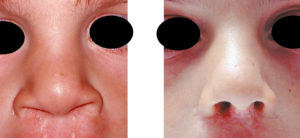Cleft lip and palate birth defects affect more than just the mouth. While the actual clefts run through the lip into the mouth, their deforming effects go beyond this area. The nose is significantly changed as well even though the actual cleft does not run through it. This is dramatically apparent in bilateral cleft lip and palate which is the most devastating form of all common oral clefts.
Unlike unilateral clefting, bilateral clefts not only pass through the base of the nose but have a very negative growth effect on the underlying premaxilla and septum as well. This creates the classic bilateral cleft nasal deformity with a short columella, broad nasal tip, flared ala, and widely spaced nostrils. All of this on top of a very thick skin cover.
Rhinoplasty in the bilateral cleft patient is very challenging. Like all cleft issues, reconstruction of the bilateral cleft nose is a process which must be viewed over years and in multiple stages. I would never call a cleft rhinoplasty complete until the patient has matured and they have decided that the result has reached a point at which they are satisfied or prefer to go no further. Unfortunately, I don’t think I have ever seen a patient in which I felt perfection had been achieved (unlike cosmetic rhinoplasty) although many have real significant improvement. While the goal is to get the best shaped and most refined nose shape as possible, a good result is one in which breathing through the nose is unobstructed and the stigmata of looking like having had a cleft is largely removed.

The most significant bilateral cleft rhinoplasty is during these teen age years. At this time, it is more appropriate to do a more aggressive and complete approach to the problem. Through open rhinoplasty incisions, the entire nose from the bony dorsum, middle vault, tip, and nostrils can be done including internal functional airway surgery. This always requires the use of extensive cartilage grafts and bony work. The thick skin of the nose, particularly over the nasal tip, is always a problem that can mask some of the restructuring that has been done underneath. This thicker skin also allows a lot of swelling to occur afterwards so one has to be patient.
Even with a complete ‘makeover’ of the entire bilateral cleft nose, such rhinoplasties usually require secondary touchups and refinement procedures. Added up all together, it is not rare that 4 or 5 efforts at the nose are made from birth to age 18. The magnitude of the nose problem, working with growth, and the scar from previous surgeries all make for bilateral cleft rhinoplasties to be a process that defies any one single operative effort.
Dr. Barry Eppley
Indianapolis, Indiana



